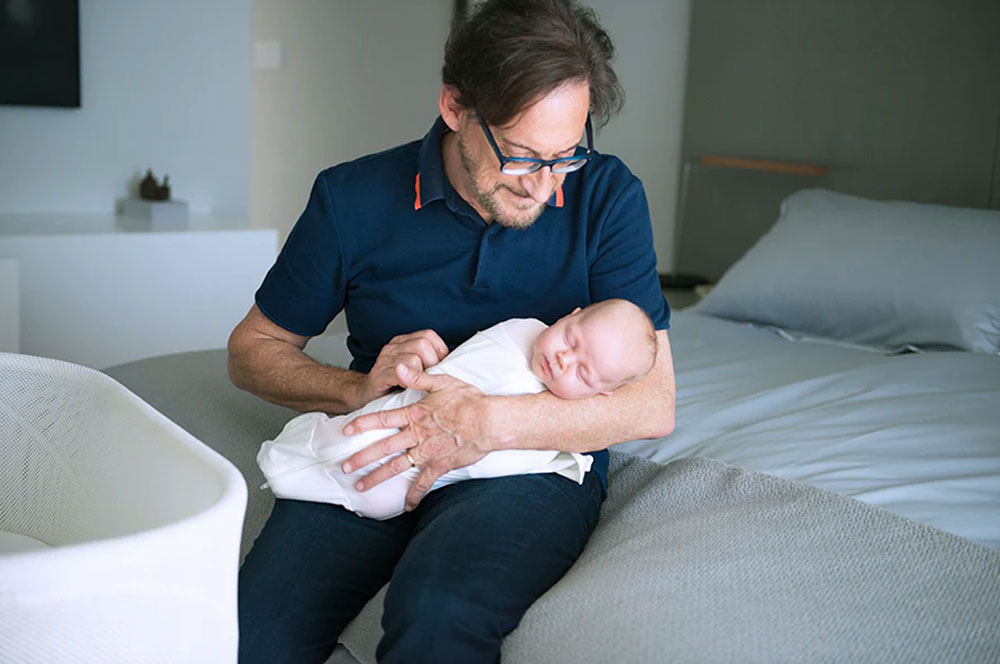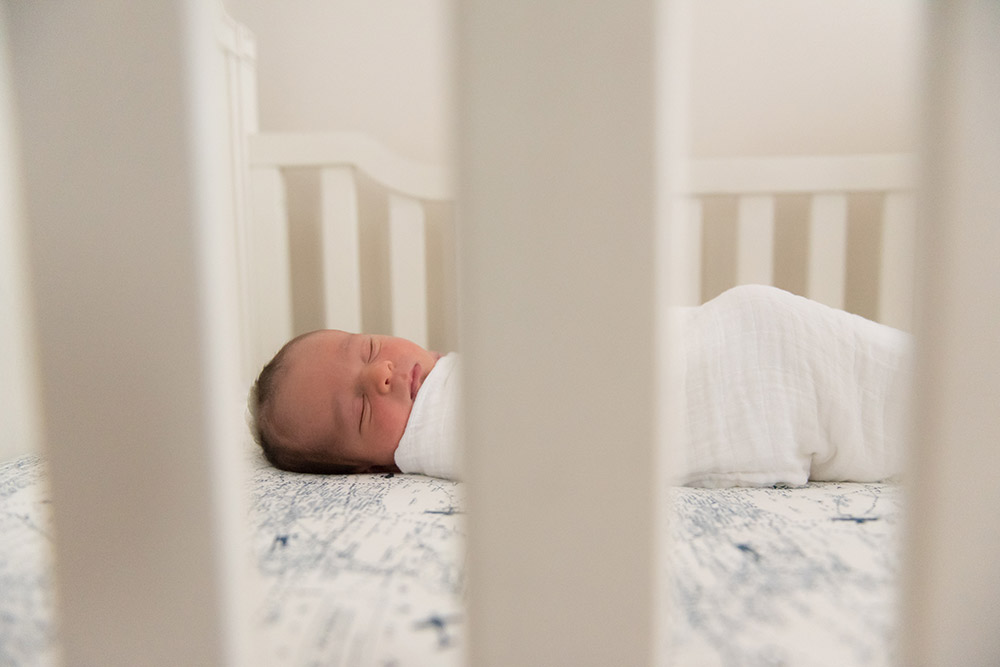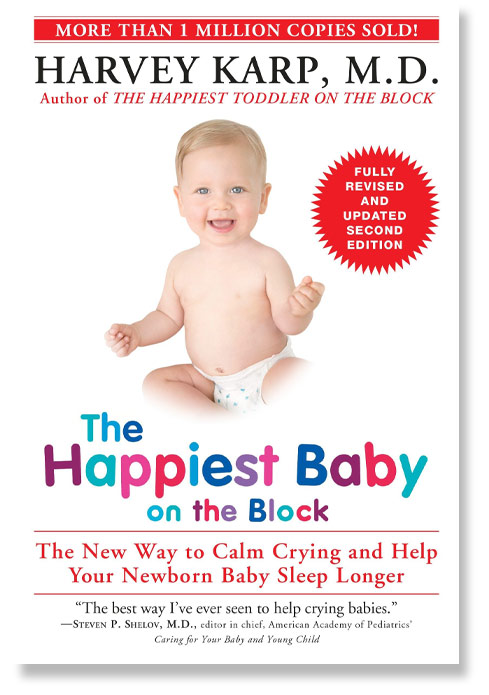Dr. Harvey Karp’s Baby Sleep Advice to Millennial Parents

We asked the sleep-training and infant-soothing expert what parents of today need to know, plus how his gentle approach still holds up after 20 years.
Expert Source: Harvey Karp, MD, FAAP
Ask any parent what was challenging about adding a baby to the family, and they’ll likely reference sleep—a lack of it, or difficulty “figuring it out.”
Baby sleep has dominated frantic 2 a.m. Google searches since internet searching became a thing. Bleary-eyed parents have routinely found themselves desperately needing information on why their newborn won’t go to bed, a plan of action to get them to sleep, and a strategy to develop long-term healthy sleep habits.
Twenty-something years ago, baby sleep and advice looked a lot different than it does today. In 1987, the extinction method (also known as the “cry-it-out” method) was first breaking ground, and up until the late ’90s, there were no video baby monitors to keep watch from afar. There were no Facebook parenting groups to turn to for solidarity and support. There were no moms on call … only moms calling out for help to get some much-needed shuteye.
When Harvey Karp, MD, FAAP, one of the most nationally recognized and respected pediatricians and child development experts in the country, founder and CEO of Happiest Baby, and author of the renowned parenting book The Happiest Baby on the Block came on the scene, he revolutionized the typical approach to baby soothing and sleeping.

His popular method of calming a fussy newborn centers around understanding a baby’s calming reflex and how it’s triggered using five steps coined the “5 S’s” for soothing: swaddling, side/stomach position, shushing, swinging, and sucking. Dr. Karp teaches that these steps simulate a womb-like experience, leading to a calmer, more secure, happier baby who in turn, sleeps better and for longer stretches of time.
“When The Happiest Baby on the Block was released in 2002, the idea of using the 5 S’s to calm babies and aid sleep was not mainstream [as it is today]. Now, the fourth trimester is literally in the dictionary, and swaddle blankets are staples of every expectant parent’s baby registry,” says Dr. Karp.
These days, the 5 S’s are taught in hospitals and parenting clinics by Happiest Baby educators throughout the U.S., not only because the tactics are effective, but because the intent behind the approach resonates with many parents today; Dr. Karp’s methods are not based on a quick-fix approach to infant sleep problems, rather, it involves helping parents understand what their babies need to feel safe and comforted—and why. This gentler, more empathetic approach is a prominent theme in modern parenting trends with what Dr. Karp calls “tried-and-true principles” to calming children and letting them know they’re understood, even at a young age.
After a highly successful career in helping thousands of new parents navigate baby sleep over the last two decades, we just had to ask the brains behind the operation: What do millennial parents need to know about their babies’ sleep?
Accept That Good Sleep Habits Take Time
If the 5 S’s are for soothing babies, then the letter P is for parental patience when it comes to facilitating a positive relationship with sleep.
“All of us have experienced a waning of patience thanks to how quickly everything moves today, from internet speed to getting packages delivered overnight,” says Dr. Karp. “But patience is necessary when you are calming a baby, and beyond that, parents need to have patience and grace with themselves, too. You [and your baby] are both learning, and it takes time.”
And helping your child develop quality sleep habits isn’t only for naps and bedtime—it’s an all-day (for many, many days) affair.
“I believe that bedtime prep actually starts after breakfast,” remarks Dr. Karp. “Getting outside in the morning lets the natural light help to regulate your newborn baby’s sleep melatonin levels, which sets the stage for successful sleep at night. What’s more, monitoring and adhering to your baby’s sleep cues and wake windows during the day will keep your little one from getting overtired and agitated.”
Contrary to popular belief, an overtired baby will not fall asleep instantly from exhaustion. In fact, Dr. Karp explains that once a baby is overtired, their fight-or-flight response is triggered, which releases the hormone cortisol that keeps them alert, preventing baby from feeling calm and ready for rest. To assist your wee one in transitioning to sleep at night, Dr. Karp recommends using the 5 S’s anytime an infant needs calming throughout the day—versus saving these tactics solely for bedtime—because “calm begets calm, and sleep begets sleep.”
While these calming techniques are very useful for readying little ones for bed, what are parents to do if their baby is waking frequently throughout the night? Where does sleep training come into play—and is it really necessary for long-term development?
Dr. Karp notes that it’s important to differentiate between sleep training and the cry-it-out method, (which are often mistakenly viewed as synonymous with one another), and understand that sleep training isn’t about getting your baby to sleep fully through the night.
“Instead, [sleep training] is about helping babies learn to self-soothe when they inevitably wake up. Nobody [regardless of age] ever really sleeps through the entire night,” he explains. “We all rouse at least three to four times a night, and babies, with their super-fast sleep cycles, are extra vulnerable to wakeups.”
Understanding—and accepting—that your child will likely wake multiple times a night can help parents prepare for what’s to come and have a better chance of remaining calm throughout the process, but what can parents do to help their babies go back to sleep and become better sleepers over time?
Dr. Karp recommends using a method called the “wake-and-sleep method,” which can be practiced with newborns from day one. In this method, a parent swaddles their infant and plays white noise to create a calming environment. Next, baby is fed and burped, and if using a pacifier, offered one when the feeding is complete. Once baby has fallen asleep in their parent’s arms, they are laid in their crib or bassinet safely on their back.
While this all may sound standard to some, the key difference in this method is that a parent will then softly tickle their baby’s feet to gently rouse them until their eyes just barely open, giving their little one the opportunity to fall back to sleep independently within a few seconds. Dr. Karp further illustrates, “As long as your baby is swaddled and shushed and their tummy is full, they should be able to fall back to sleep quickly with little crying. Do this each time you put your baby down for sleep, and they’ll build confidence in their self-soothing abilities and be able to do it on their own.”
Prioritize Stress Management
When asked what he would change if writing Happiest Baby on the Block today, Dr. Karp emphasized the importance of parents getting the help they need before baby arrives, from an extra set of hands around the house to breastfeeding support.
“Too many new mothers think that a ‘normal’ mom does it all on their own—and looks beautiful in their Instagram photos doing it. That’s a myth. New parents need and deserve help,” he says.
Adequate support is important for healing, bonding, and stress management, which can impact a parent’s ability to be present and learn about their new baby.
“Stressed-out parents can be more distant, less engaged, and inconsistent in meeting their baby’s emotional needs,” says Dr. Karp, noting that the pandemic in particular added significant stress to families and made quality of sleep an ongoing issue for many households. Not only that, but parental stress also affects the success of building those crucial good-sleep habits early on in an infant’s life.
“Your baby’s wailing can often trigger a red alert in your nervous system, making you feel tense and anxious, complete with a pounding heart. If you’re [experiencing stress], feeling incapable of soothing your crying baby can push [any parent] into panic and anger,” says Dr. Karp. “When a stressed-out parent gets panicky, it’s harder to soothe a fussy baby. But if you focus on the 5 S’s, you will not only help soothe your baby, you will sidestep the added stress that comes with incessant crying.”
Aside from the 5 S’s, parents can try easing their own stress by incorporating stress-reducing activities into their day, whether it’s going for a walk, doing a short meditation, or relying on friends, family, or a hired service to help in whatever way is needed.
Utilize Technology in a Smart Way
We love technology, and Dr. Karp believes it should be used by parents if it’s safe and proven to make their lives easier or safer.
For example, white noise machines can be substituted for the parent “shushing” step in the 5 S’s (though rest assured the regular shushing works just fine to temporarily calm crying if away from home without a portable version).
“We know that the very best sound for calming fussing is a rough, slightly harsh noise that’s as loud as your baby’s wails,” says Dr. Karp. “But it’s simply not possible to [continually shush] in your baby’s ear for all naps and nights.
“There are many white noise machines out there, but only continuous, monotonous, and low-pitch sounds work to lull babies to sleep. And the very best white noise for sleep mimics the loud, rumbly sounds a baby hears in the womb.”
Another recommendation he suggests is using his award-winning SNOO, a smart bassinet that essentially acts as an extension of the 5 S’s approach to soothing babies to sleep. The SNOO safely swaddles infants on their backs and uses continual white noise and gentle rocking motions to help maintain a calming environment. The responsive technology “listens” to babies during the night and responds if it senses they need more white noise or increased rocking to fall back to sleep. (Parents can either purchase or rent the SNOO for different monthly increments.)
And when it comes to smartphones, Dr. Karp says they can certainly be helpful with using white noise on the go and creating a sleep schedule for your baby, but ultimately, they should be used mindfully to avoid adverse effects.
“Research has shown that parent phone use is associated with less verbal interaction, lower responsiveness, and even harsher parental responses,” he explains. “I’m not suggesting that parents toss their smartphones—everyone deserves a ‘time out’ to mindlessly scroll or exchange texts with friends. But all of us could benefit from setting limits on our screen time to be as present as possible.”
In addition to these potential consequences, the blue light emitted by smartphones and other digital devices mess with human melatonin levels and sleep; a lack of sleep then creates more stress, circling back to difficulties soothing baby and establishing better sleep habits as mentioned above. It’s a vicious cycle that can be remedied, in part, by disconnecting from devices and plugging into time spent resting.
Remember the Long-Term Benefits
The days are long, and the nights are even longer, but you’re helping your child develop a foundation that will last well beyond bedtime. Children who regularly get adequate sleep have improved attention, behavior, learning, memory, and overall mental and physical health.
Another potential perk to gently teaching babies to be better sleepers is that you’ll likely continue gentle practices in moments of tension as they grow, which Dr. Karp affirms is an effective way of parenting children of all ages. In fact, he notes that respectful communication, treating children with dignity, and validating their feelings are all techniques at the heart of his newer The Happiest Toddler on the Block book.
“As challenging as the first six months [of a baby’s life] may be, the next three years are incredibly important in terms of [raising] a person who feels loved and deserving of love,” he says, and offers parents an added takeaway from his book for the trying toddler years.
“I teach parents something I call ‘The Fast-Food Rule.’ It’s an amazing way to prevent and calm tantrums [with young children], but really it’s just a respectful and effective way of communicating with anyone who’s upset.
“The Fast-Food Rule says that when you talk to someone who’s having a hard time, you always repeat their feelings first before offering your own comments or advice, in the same way a fast-food worker will repeat your order back to you before, say, asking for payment. But what’s really important is that when you repeat what a person has shared with you about their feelings, you mirror about one-third of those feelings with your tone of voice and gestures.
“Even though talking to your tot in this new way might feel funny the first time or two, it makes children feel like you really hear and understand them—where using a flat tone or syrupy voice that doesn’t match their mood might seem dismissive of those big emotions. Everyone—especially toddlers—just want to be understood!”
We know getting your baby to sleep can be a huge challenge for all parents, but by understanding the vulnerabilities they’re experiencing, and by having some practical tools to help them feel safe and secure, you can start laying the groundwork for long-term quality sleep—one (5 S’s) step at a time.
Image of Dr. Karp courtesy of Happiest Baby.








